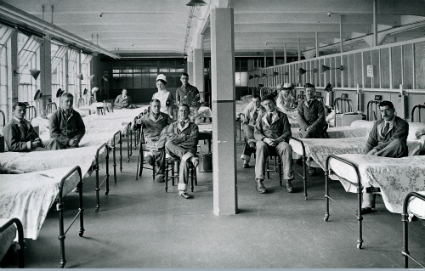A World War One Military Hospital
With the 100th anniversery of the Battle of the Somme coming up recently we were moved to visit the medical care of World War 1.

This is King George Hospital, a giant military hospital in Stamford Street, Waterloo, London. If it looks like they're sitting in a warehouse it's because they are. The hospital was created out of a requisitioned, repurposed warehouse, which apparently took some doing, between modifying the original structure and labor problems. The hospital opened at the end of May 1915 and closed June 15, 1919.
http://ezitis.myzen.co.uk/kinggeorgestamford.html has a bunch of fascinating facts about this hospital. What struck us was the nursing staffing for the wards. There was a matron, three principle sisters, 10 senior sisters, and about 33 nursing sisters. For a hospital with a census of 1500-1800 patients. Each of the five patient care floors had about 300-350 patients, with a night supervising senior sister and a day supervisor. Five to seven nursing sisters were assigned to each floor, making a nurse to patient ratio of 1 to 50. Obviously, they didn't get a lot of time off. The nurses were technically on duty 22 out of 24 hours (one hopes that, even with the traditional British mind-over-matter attitude they got more than two hours sleep a night) and had one half-day a week and one "weekend" (6 pm Saturday to 10 pm Sunday) off a month. They were assisted by about 200 "orderlies" who presumedly did the transporting and heavy lifting, and a number of volunteers. However the nurses at this time were not only responsible for nursing care, but also for housekeeping and maintaining the staff quarters.
For all this they got 40 pounds a year, which apparently was felt to be quite generous. Of course, the nursing staff all lived at the hospital and probably got free or reduced room, board and laundry. Still, even back then 40 pounds wouldn't go that far.
The men in the photo above are less acute cases. They are ambulatory and wearing the (in)famous blue "convalescent suits" issued to military personnel in a hospital status. However, even the more acute ward photos are somewhat staged. All the patient's clutter is put away and there are no stray trays or laundry laying around. Also, even though in many photos the patients are clearly bed-bound or have limited mobility, there are no chair side commodes, bedpans, urinals or chamber pots visible. It was undoubtedly someone's job to shove all those out of the way, before the photo was taken.

Comment on this story using Facebook.